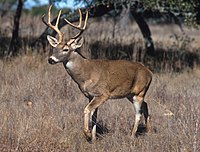
Photo from wikipedia
Predators and prey engage in games where each player must counter the moves of the other, and these games include multiple phases operating at different spatiotemporal scales. Recent work has… Click to show full abstract
Predators and prey engage in games where each player must counter the moves of the other, and these games include multiple phases operating at different spatiotemporal scales. Recent work has highlighted potential issues related to scale-sensitive inferences in predator-prey interactions, and there is growing appreciation that these may exhibit pronounced but predictable dynamics. Motivated by previous assertions about effects arising from foraging games between white-tailed deer and canid predators (coyotes and wolves), we used a large and year-round network of trail cameras to characterize deer and predator foraging games, with a particular focus on clarifying its temporal scale and seasonal variation. Linear features were strongly associated with predator detection rates, suggesting these play a central role in canid foraging tactics by expediting movement. Consistent with expectations for prey contending with highly mobile predators, deer responses were more sensitive to proximal risk metrics at finer spatiotemporal scales, suggesting that coarser but more commonly used scales of analysis may miss useful insights into prey risk-response. Time allocation appears to be a key tactic for deer risk management and was more strongly moderated by factors associated with forage or evasion heterogeneity (forest cover, snow and plant phenology) than factors associated with the likelihood of predator encounter (linear features). Trade-offs between food and safety appeared to vary as much seasonally as spatially, with snow and vegetation phenology giving rise to a "phenology of fear". Deer appear free to counter predators during milder times of year, but a combination of poor-foraging state, reduced forage availability, greater movements costs, and reproductive state dampen responsiveness during winter. Pronounced intra-annual variation in predator-prey interactions may be common in seasonal environments.
Journal Title: Ecology
Year Published: 2023
Link to full text (if available)
Share on Social Media: Sign Up to like & get
recommendations!